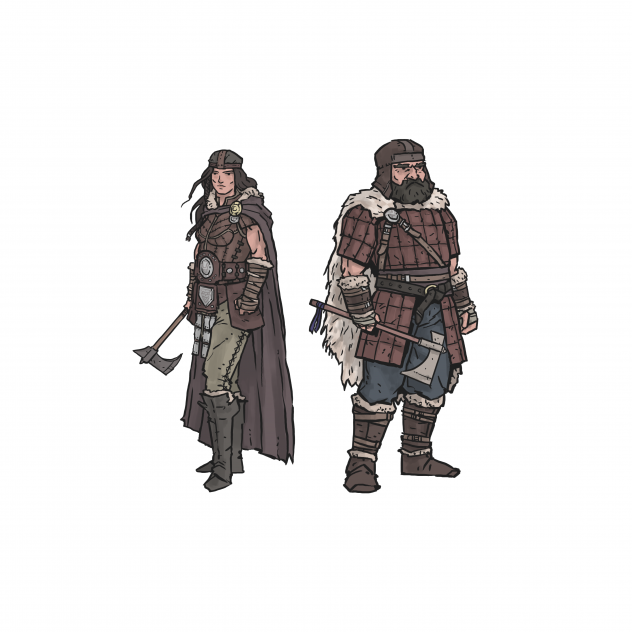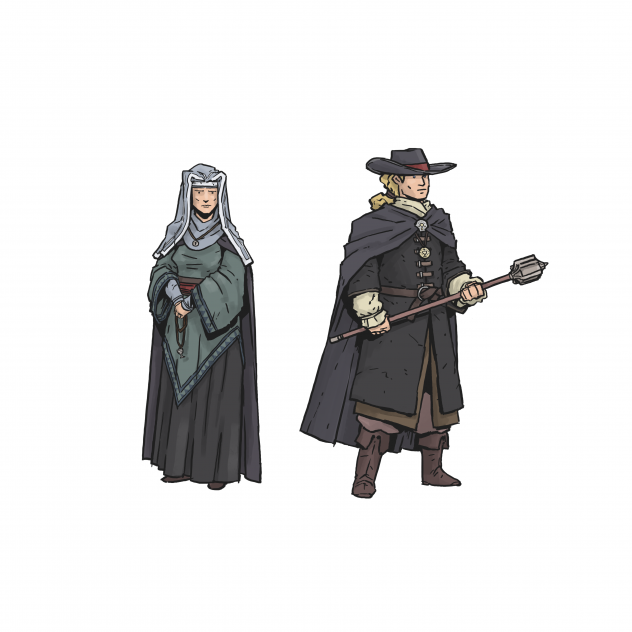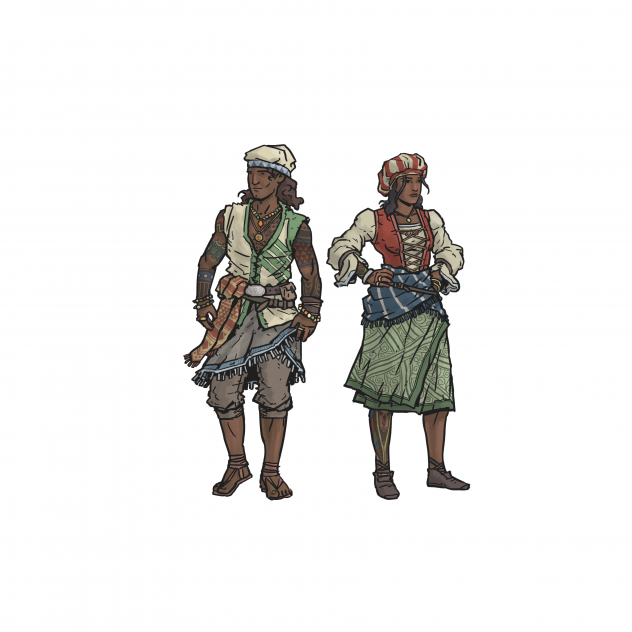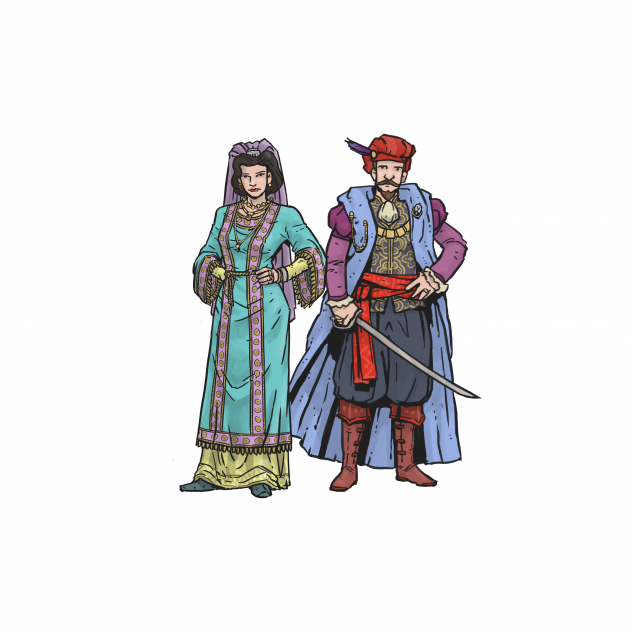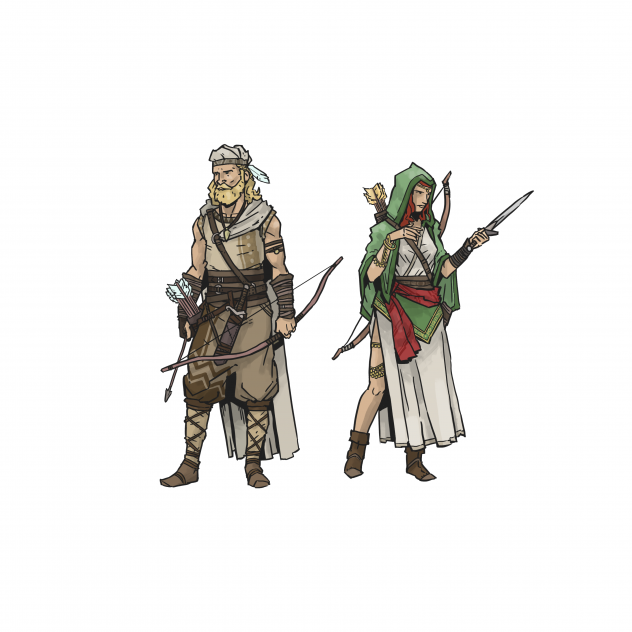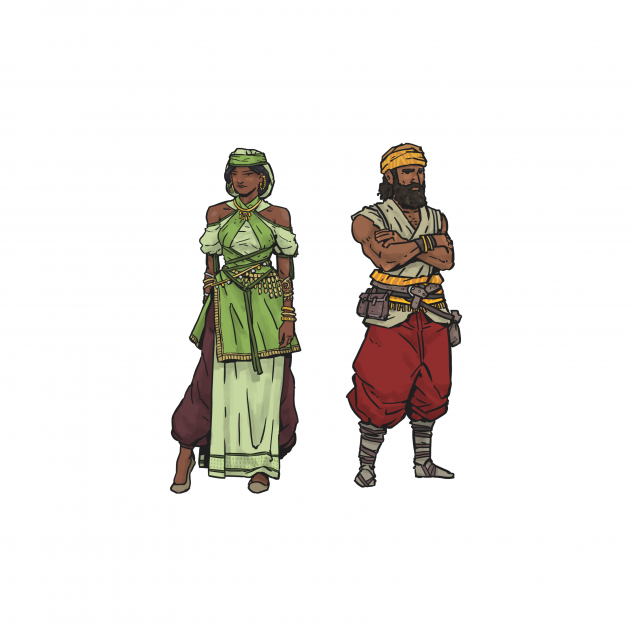Vandagan
FEATURES
The Vandagan people hail from the unforgiving, cold northeastern duchy of Vandago; the harsh climate keeping Vandagans indoors and in close quarters for large parts of the year has made Vandagan culture a necessarily political one with an emphasis on etiquette, protocol, and simply not making the lives of one’s house members more difficult than they must be – as a result, eve the Vandagan freemen may be perceived as a little bit pompous or at least
arrogant amongst those of the other duchies.
Vandagans are perhaps most well-known for their architecture, engineering, and love of the natural sciences. Though Vandagans are sometimes viewed by others as sullen and morbid with a bleak sense of humor, the Vandagans themselves value the pursuit of education and indulge in pastimes such as music, literature, and debate.
Vandagans are dark-complexioned, with black to brown hair coloring of a variety of textures being the most prevalent. They are known for their canted, generally light eyes that provide a striking contrast to their otherwise dusky tones. They tend to be of the stockier, more muscular build than their neighbors.
Average Statistics:
Female: Height, 1.63m (5’4″ ft), Weight 52 kg (114 lbs)
Male: Height 1.67m (5’6″ ft), Weight 63 kg (139 lbs)
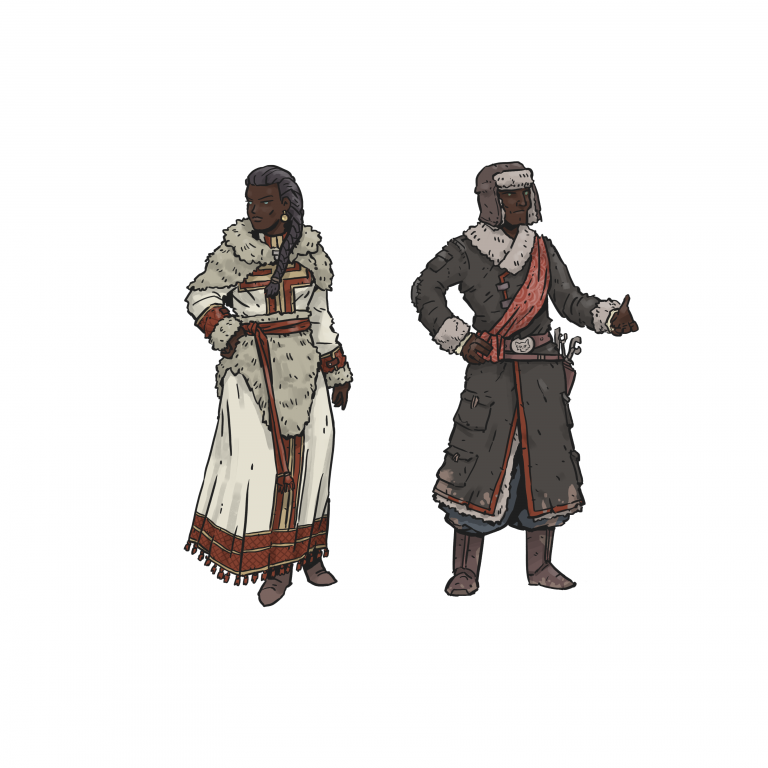
FAITH
Tithes are strictly enforced and considered an important duty of the populace, which they take seriously. As such, the Vandagan church has a great deal of wealth at its disposal. Even as Vandagan families take great pride in their houses, their communities are especially proud of their churches and cathedrals, building elaborate monuments to the Lord of the Springs and Vandagan architecture in one. The splendid and elegant clerical vestments common among the clergy tend to echo elements from architecture as well, for example patterns echoing stained glass windows.
Mass in Vandago is very similar on the whole to Lithmorran Mass, and often tends to copy the scripture and format exactly, though they focus less on community activities and public forum than on riveting, passion-inspiring sermons. The orations of Vandagan priests are well-known for their zeal, though a Lithmorran would perhaps criticize them for a lack of overall substance.
FASHION
Engineers at heart, Vandagan fashion is a unique combination of smart, sharp-edged design and clever function. Clothing, to a Vandagan tailor or seamstress, is not simply viewed as a matter of style and beauty, but also a puzzle to be solved.
As Vandagans move from the frigid outdoors to the warm indoors, they tend to dress in layers; while the attire of the working-class channels the Vandagan engineering skill in its simplicity and functionality, the formal ensembles and court gowns worn by the upper classes are engineered works of art with folding, buttoning, and removable parts allowing a seamless and fashionable transition from cold to warm surroundings.
Wealth has a different impact on Vandagan dress than it does in other duchies; while type of material is still an overt indicator of a garment’s price, Vandagans also look to an outfit’s complexity and cut: Vandagan women in particular will flaunt their ability to show bare arms, ankles, and collarbones in their well-insulated and thus luxurious homes while still making ample use of fur-trimmed, embroidered, and otherwise heavily-embellished layers.
A few garments in particular are iconic of Vandagan cultural dress:
Greatcoats: The Vandagan greatcoat is perhaps the most universally “Vandagan” item of clothing; worn by all classes, it is typically a heavy wool coat with long tails, removable lining, and internal pockets. Embroidery, buttons, buckles, and the quality of wool is what sets finer coats apart from more practical ones; certain types of Vandagan wool cloth spun with silver or gold thread can easily price as highly as garments made of Vavardi painted silk.
Ushanka: The fur or felt ushanka is a cap with ear flaps that can be untied and folded down to insulate the ears in inclement weather, or flipped back up to form a stylish brim.
Corset: The six-panel steel-boned corset was invented in Vandago as an improvement on the rigid bodice; while it’s intended to be worn strictly as an undergarment beneath a gown, certain younger, more daring, or – dare one say – looser women wear corsets overtop their gowns or (Lord forbid) instead of a bodice to achieve a racy effect.
Sash: A Tubori introduction, the Vandagan-style sash is tied more tightly and used to hold layers of clothing in place; more decorative ones are woven wit complex arrow patterns, and many naval officers will have a silk shoulder sash as part of their formal regalia.
Sarafan/Mantua: Vandagan women who wish to make an impression will often appear in bell-shaped mantuas or Vandagan-style court gowns with ostentatious skirts and removable trains, while typical Vandagan gentrywomen and freewomen will go about their day-to-day in a comparitively (though by no means objectively) simple sarafan.
Rubakha/Waistcoat: Vandagan men of the gentry class will often wear finely-cut waistcoats made of fine wool cloth or silk, whilst their freemen counterparts will wear the traditional, narrow cut rubakha under a tailored vest.
Cravat/Fichu: Men and women both fill the space between their chin and bodywear to protect their necks from cold – men with layered cravats and women with the fichu – a tear-away kerchief designed specifically to protect the upper chest and neck from the cold.
TRADE
Most of Vandago’s trade industry is in trade itself; with the only reasonably direct passage from the Dralth to the Kirulean, Vandago’s central domains boast bustling tradeports.
Vandago’s prime export is stonework and architecture. Blessed with an excess of fine stone, Vandagans have seized upon this advantage to export not only the raw material but the finished project and the workers who finish it. Famed for the creation of St. Aelwyn’s Cathedral in Lithmore, Vandagans regard architecture as an extremely high art, with sculpture not far behind. A majority of schools in the duchy focus on either the principles of stone-working as art or science, and even a Vandagan who can’t read can likely tell the difference between one type of rock and another.
Rich red and purple dyes produced from snails pad the economies of the northernmost domains, and the more temperate countrysides produce many heavier and finer wools than the types found in Lithmore. Vandagan wool is famed for its softness, comfort and warmth; Some of the most masterfully-produced cloth is woven with spun silver or gold thread and can cost easily several times more than silk or velvet.
Vandago is also known for a few various and sundry other exports, such as fine paper produced from plants that grow along the shore of the ocean, fine steel coveted by master blacksmiths throughout the Kingdom, and a truly gigantic breed of pigs that gave rise to the famous mention in the Anjene Divine- “Vandagans have the biggest swine.” These enormous hogs are exported as curiosities, delicacies, and sometimes simply to kitchens that need to order more or less ‘in bulk’.
FOOD
Vandagan food is generally hot, dense, and nourishing pork, venison, fish, and hardy vegetables such as potatoes, beets, mushrooms, onions, carrots,
celery, and cabbage are staples Vandagans will incorporate fruits and berries into their diet seasonally, and make ample use of spices such as garlic,
ginger, and dill. When available, Vandagan cuisine makes ample use of heavy cream and butter, and dense breads are served with almost every meal.
The Andirian River is full of pike, salmon, and other freshwater fish. Most coveted are Andirian Trout and the freshwater sturgeon from which the Vandagans get their caviar. Duck mussels can be found in the stretch of the Andirian that runs through Mozenk, and the most southerly domains enjoy Kirulean seafood as well.
Vandagans have what might be described as a particularly honest approach to confectionery, favoring heavy, unrepentantly sweet desserts made of stewed native fruits and sugary pastry paired with spiced black tea. Two sweet dishes that may be described as “particularly Vandagan” are a heavy, dense caramel cake invented for Duchess Ianka and the small, nutty potato candies enjoyed on occasion by even the poorest Vandagans.
Beer and ales brewed from beets or berries are universally enjoyed, as are lighter fruit and elderflower ciders, and red wines of Vandago’s own vineyards and Vavardi import. While the stereotype of Vandagans as vodka-drinkers refuses to be put to rest, as much vodka is made in Lithmore as in Vandago and it is no more popular than any other drink- though the finest of the fine is made with Vostocki mountain spring water.
Due to the short growing season, Vandagans are known to pickle just about everything from mushrooms to fish in salt and vinegar what can’t be pickled is made into jams and jellies.
CUSTOMS
Wedding Rings: The Vandagans consider marriage to be sacrosanct and it is highly venerated in their society. During the wedding ceremony, a couple will exchange rings as a symbol of the eternity of their union. Wedding rings also function as an outward sign to those around them that they are indeed wedded, and it is a proclamation proudly worn.
Funerals: Contributing to the Lithmorran stereotype of Vandagans as a morbid, dour, death-obsessed people, Vandagans tend to spend a relatively large amount of time and money on death and the mourning process. It is not unheard of for the wealthiest Vandagans to spend a life’s savings on lavish stone mausoleums, extravagant statues, or bizarre memorials; the rest will at least maintain elaborate shrines to deceased loved ones, and sometimes a room in a house will account for generations of dead family. The mourning period for an immediate family member lasts one year, and Vandagans in mourning will typically dress in black with women wearing sheer veils over their faces. Memorial jewelry is crafted of precious stones and metals or sometimes even woven out of the departed’s cut hair. To a Vandagan, a funeral is the last chance to prove how wealthy, important, and worthy of remembrance one is; one’s own funerary preparations are approached with an enthusiasm that Lithmorrans may find offputting.
Fragrance: Vandagans make ample use of perfumes, colognes and fragranced oils; in addition to acting as one more ensemble accessory, liberal use of perfume can easily mask the fact that one may not have bathed for the deadest weeks of cruellest eastern winters.
Candle Blessing: On the first day of spring, the faithful gather for a specially held ceremony in which each individual lights a candle and a priest blesses the year to come. While the priest recites their choice of well-wishes and prayers, each person holds their lit candle under the throat to allow the warm and dry influence of flame to purify and balance the humors in the lungs after the cold and damp winter months. In the same vein, Vandagans pray for inspiration to be relieved of any ill feelings, bile, and taint accumulated during the darkest season.
Ice Swim: This unusually adventurous Vandagan tradition typically takes place in Januarius. Men and women strip down to as little clothing as decency allows, then dive separately into a body of frigid, icy water. Meant to honor the Lord of the Springs, the ice swim is believed to be both cleansing and reinvigorating for mind, body, and spirit. The practice was brought to the fore in Lithmore’s capital in SC 379 by the visiting Lord Kirill von Dmitreva, Count of Garod.
FAMILY
The Vandagan culture has taken several elements from its trade partner and former owners in Tubor and merged them with classical, mainland Davism, sometimes taking some of the more extreme elements of each. The result is a city in which prosperity has reduced birthrates to three per family (slightly higher among the lower classes), while the average age at marriage (twenty) is the highest in the kingdom. Large age differences between husband and wife are frowned upon more here than elsewhere, and families retain virtually no contact with their more distant relatives. Annulments and divorces are totally unknown in Vandago, one of the few key points on which the Vandagan clerics are more strict even than Lithmorran ones.
CLIMATE
The Vandagan architectural skill is sometimes explained as a natural consequence of the deadly winters that Vandago is known for – indeed, the sole image that blossoms in many minds when Vandago is talked about is likely harsh, endless tundras, dead northern frosts, the blizzards, or the towering cobalt and white Vostock Mountains.
In reality, there is also a relatively mild summer season with a plentiful growing period to counter the harsh winters in much of the duchy. Rains gently nourish vineyards and lush forests in the southern half of the duchy. Lillton and Batarostra are notable for their wildflowers (as is Vostock for its snowdrops in particular), and Traghow for the dense and mysterious Evernight Forest from which much of Vandago’s superstition and folklore creeps.
The northern taiga is stunted by the winter weather, and only the hardiest of wildlife makes its home there – unsurprisingly, many Vandagans choose to identify best with the strong, resilient taiga bears, but certain lynxes, reindeer, squirrels, and wolves also make their home in the North.
With a mountain range (referred to by Vandagans as the Stag’s Spine) separating Vandago from the Charalin Plains, storms spend themselves against the slopes that shelter the quarries and mines, leaving the northern Plains a desert. The Kirulean coast is milder than any other part of Vandago with plentiful bays and coves for legal and illegal shipping to Lithmore and Vavard.
MORALS
The Vandagans are above all, a proud people, always starkly conscious of where they stand in relation to each other and the rest of the world.
Vandagan House politics can be messy and delicate in a way that a Lithmorran would find bewildering, and as the shame of one can bring shame upon the whole house, families put tremendous pressure on each other to behave “as is expected.” In public, morality may appear to be even tighter than it is in Lithmore, even despite the more liberal attitude towards fashion.
Sins are, as they often are in duchies beyond Lithmore, regarded in different order of severity, with more emphasis placed on one’s role in the House and the shame that might be brought about – the Vandagan devotion to the House is echoed in their Tubori cousins’ concept of The Family. It’s considered terribly immoral to deny your station and act below it; it drags down one’s House members and threatens to spark anarchy in the Kingdom, but political plays to transcend one’s station – or at least approach it creatively to secure power and prestige – are viewed with a tacit approval (especially if one is successful). In a similar vein, births outside of wedlock and other conjugal sins that threaten to stain the House with unpredicted, unwanted blood are viewed with an almost unsurpassed blackness.
Marriage is particularly sacred in Vandago, as stability and order is prized; marriage is never to be rushed or hurried, only proposed when both Houses have considered all options and agree on what would be the most advantageous step. Annulment and divorce bring about shame so great that they are often simply not permitted – indeed, “a Vandagan does not divorce” has been spoken as a subtle threat on the life of more than one particularly embarrassing partner. At the very least, Vandagans enjoy the sense of security when it comes to cementing trade and noble alliances; it’s not hard to pay lip service to the importance of two souls wedding for life under the Lord.
In private, Vandagan morality tends to be looked upon with a clear-eyed practicality. While Vandagans would never allow themselves to be anything other than faithful sons and daughters of the Church, at times, their religious devotion may appear somewhat shallow; a road to success rather than true faith. A Vandagan might find it easy to ignore, or at least refuse to investigate sins in their own house; family members might turn a blind eye to even the gravest debauchery so long as they’re not forced to address it in public or otherwise deal with it. Embarrassing a spouse by allowing an affair to come to light, for example, and forcing them to mend their reputation is perhaps regarded as more dire a breach of etiquette than the affair itself; the Vandagan attitude is that it’s not polite to burden others with one’s dirty laundry.
Sins relating to greed and vanity tend to be swept under the rug entirely; it’s said that a Vandagan is only content with his lot in life after he’s dead. The continual struggle to better oneself, while usually driven more by political plays for power, is inextricably linked with wealth, and thus, most tend to turn a blind eye to usury and graft. Only when the Church is not receiving its proper tithes does this become a matter of concern.
PERSPECTIVE
These quotes generally sum up the Vandagan thoughts about those from other regions from the perspective of Vandagans themselves:
Lithmorran:
“Well, we’re a lot like Lithmore. We have been since Jaren’s time. But even we can see they’re more than a little bit backwards these days. Avoiding the real world just makes one’s faith suffer a bit; the Lithmorrans are so blind to reality, but it’s charming in a childlike way.”
Vavardi:
“A clever front for the Cult of Transcendent Ecstasy! Soon, we’ll supplant them as the economic powerhouse, and they’ll be left with nothing but their illicit affairs, public bathhouses, and gaudy clothes.”
Charali:
“Hard to say. Never seen one. Though, if they got into a fight with Vavard, it would be difficult to cheer for the Vavardi.”
Hill Folk:
“Simple-minded fanatics… but I wouldn’t say it to their face.”
Tubori:
“Colorful folk. It’s amazing they don’t freeze to death exposing so much skin.”
Farin:
“Too much tabac smoke and frivolous festivals. A peculiar aversion to a good glass of wine. But overall, their hearts are in the right place.”
Daravi:
“The Daravi Sultanate is in the perfect place – as far from us as possible.”
Order:
“Stalwart defenders of the faith, our spiritual leaders, and those who will lead us to the side of the Lord. It’s blasphemy to think anything else.”
Reeves:
“It’s hard to argue with law and order.”
Troubadours:
“Anyone who wants a career in politics must have one: a bard is almost as necessary an adviser as water to a man dying of thirst.”
Brotherhood:
“A very prosperous cartel. Cartels, however, undermine the tenets of good government.”
The Knights:
“The destination of many gentlemen and noblemen. A finer institution to which one might aspire could never be conceived.”
